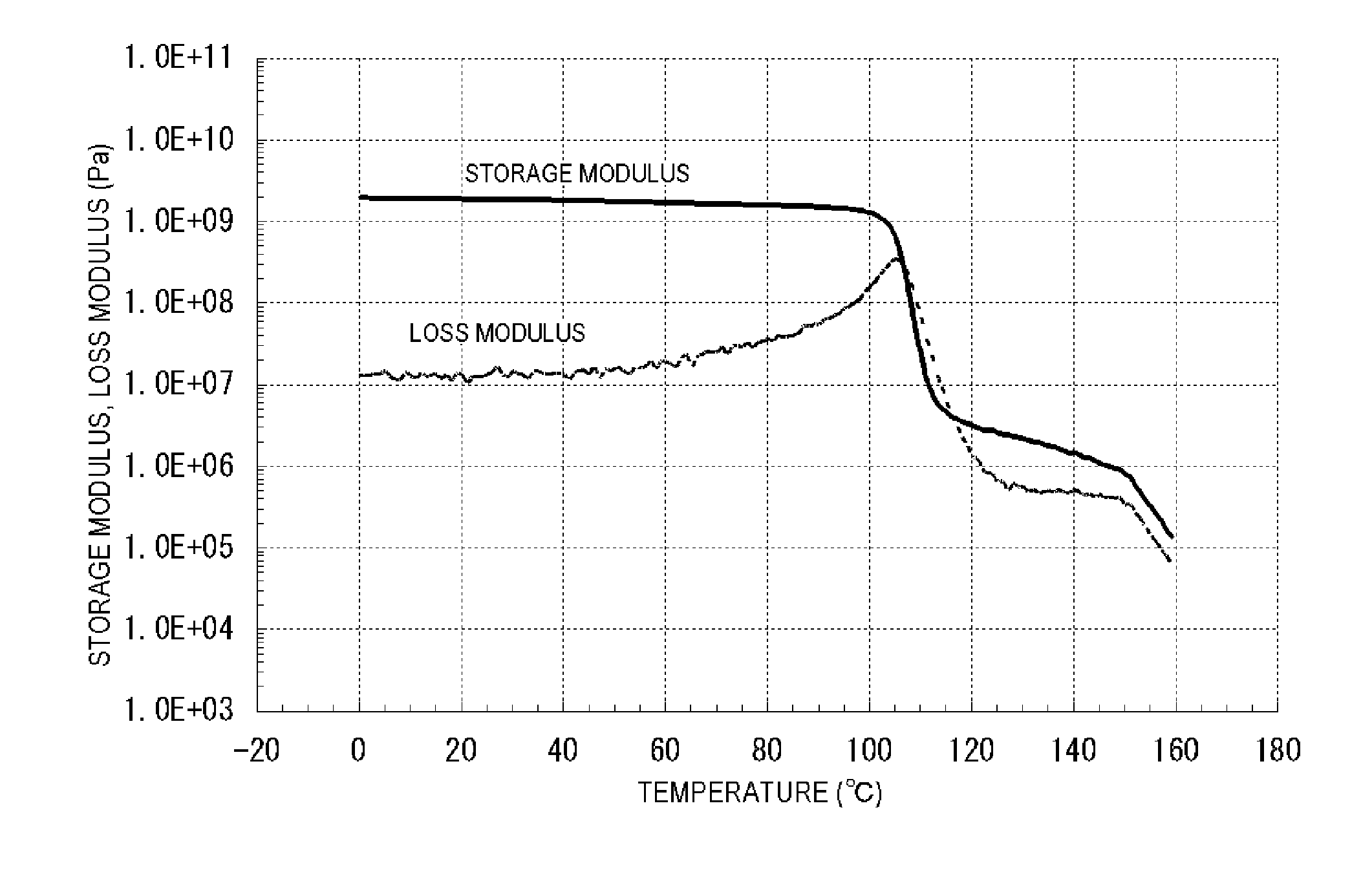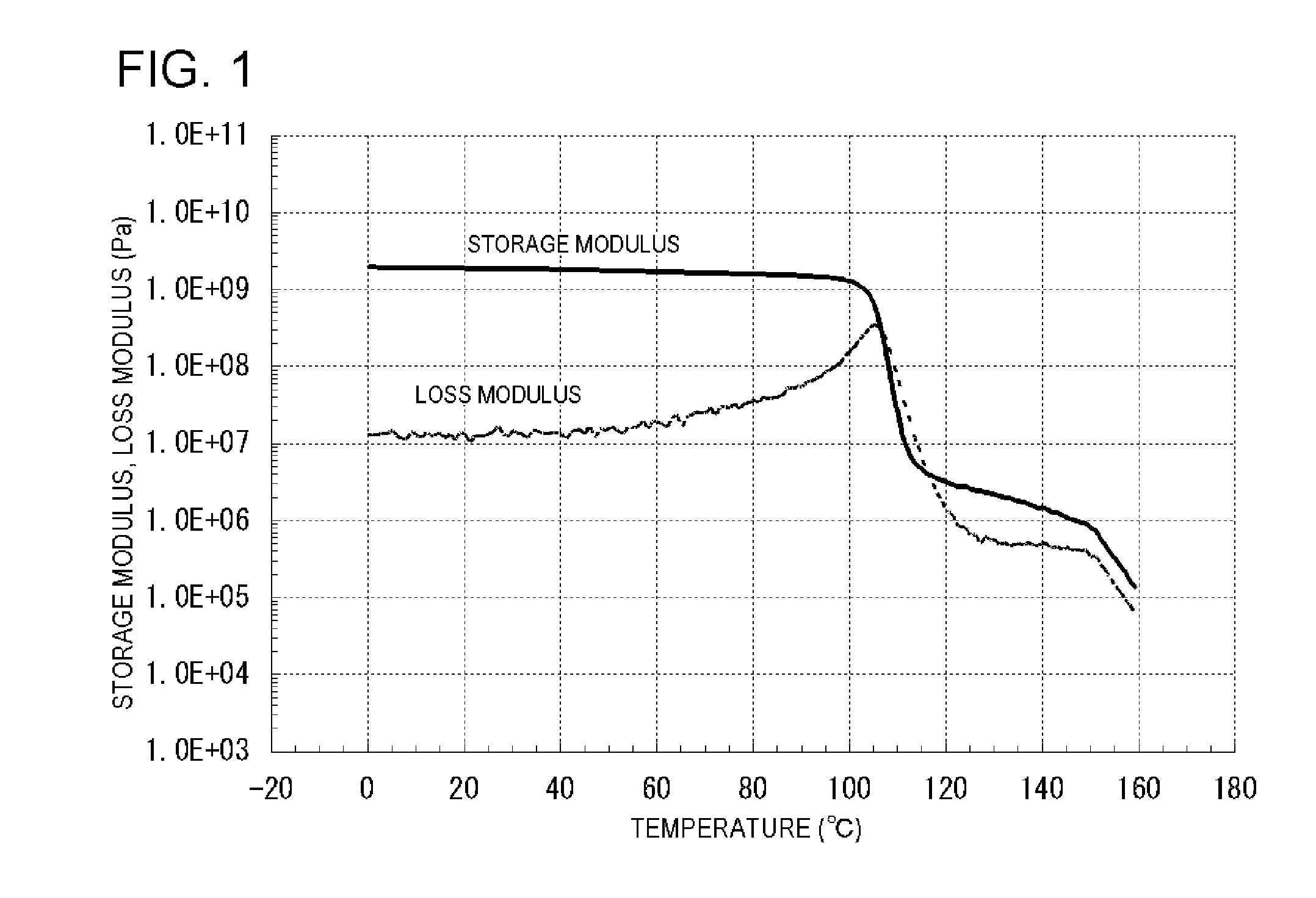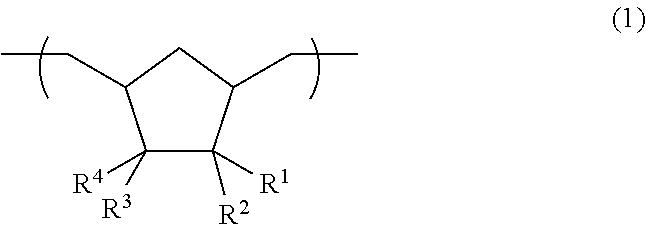Fluorine-containing cyclic olefin polymer composition, imprint product obtained using the composition, and method for producing the same
a technology of cyclic olefin and polymer composition, which is applied in the direction of printing, transportation and packaging, instruments, etc., can solve the problems of reducing the shape precision of fine patterns in the imprint product, reducing pattern precision, and not smoothly releasing the moulding, so as to improve the hardness, improve the effect of modulus and optimize the modulus chang
- Summary
- Abstract
- Description
- Claims
- Application Information
AI Technical Summary
Benefits of technology
Problems solved by technology
Method used
Image
Examples
example 1
Synthesis of poly(1,1,2-trifluoro-2-trifluoromethyl-3,5-cyclopentylene ethylene)
[0744]To a solution of 5,5,6-trifluoro-6-(trifluoromethyl)bicyclo[2.2.1]hept-2-ene (100 g) and 1-hexene (268 mg) in tetrahydrofuran was added a solution of Mo(N-2,6-Pri2C6H3)(CHCMe2Ph)(OCMe(CF3)2)2 (70 mg) in tetrahydrofuran solution, followed by carrying out ring-opening metathesis polymerization at 70° C. The olefin portion of the polymer thus obtained was subjected to a hydrogenation reaction at 160° C. with palladium alumina (5 g) to obtain a solution of poly(1,1,2-trifluoro-2-trifluoromethyl-3,5-cyclopentylene ethylene) in tetrahydrofuran.
[0745]The solution was added to methanol, and a white polymer was separated by filtration and dried to obtain 99 g of a polymer. The hydrogenation rate was 100%, the weight average molecular weight (Mw) was 127000, the molecular weight distribution (Mw / Mn) was 1.70, the glass transition temperature was 109° C., and the fluorine atom content rate was 52.3% by mass.
[...
example 2
Synthesis of poly(1,1,2-trifluoro-2-trifluoromethyl-3,5-cyclopentylene ethylene)
[0747]In the same manner as in Example 1 except that the catalyst was changed to Mo(N-2,6-Pri2C6H3)(CHCMe2Ph)(OBut)2 (50 mg), poly(1,1,2-trifluoro-2-trifluoromethyl-3,5-cyclopentyleneethylene) was obtained (98 g). The hydrogenation rate was 100%, the weight average molecular weight (Mw) was 83000, the molecular weight distribution (Mw / Mn) was 1.73, the glass transition temperature was 108° C., and the fluorine atom content rate was 52.3% by mass.
[0748]Subsequently, the obtained polymer powder after the hydrogenation was hot-pressed to produce a hot-pressed sheet having a thickness of 0.37 mm. As seen from the results of the measurement of the dynamic mechanical analysis by tensile mode, the storage modulus in the range from 109° C. to 150° C. was from 4.98 to 0.58 MPa, the loss modulus in the range from 113° C. to 150° C. was from 2.96 to 0.31 MPa, and the change in the storage modulus and the change in ...
example 3
Synthesis of poly(1,2-difluoro-1-trifluoromethyl-2-perfluoroethyl-3,5-cyclopentylene ethylene)
[0749]In the same manner as in Example 1 except that the monomer was changed to 5,6-difluoro-5-trifluoromethyl-6-perfluoroethylbicyclo[2.2.1]hept-2-ene (50 g) and the catalyst was changed to Mo(N-2,6-Pri2C6H3)(CHCMe2Ph)(OBut)2 (17 mg), poly(1,2-difluoro-1-trifluoromethyl-2-perfluoroethyl-3,5-cyclopentyleneethylene) was obtained (49 g). The hydrogenation rate was 100%, the weight average molecular weight (Mw) was 95000, the molecular weight distribution (Mw / Mn) was 1.52, the glass transition temperature was 110° C., and the fluorine atom content rate was 59.7% by mass.
[0750]Subsequently, the obtained polymer powder after the hydrogenation was hot-pressed to produce a hot-pressed sheet having a thickness of 0.37 mm. As seen from the results of the measurement of the dynamic mechanical analysis by tensile mode, the storage modulus in the range from 115° C. to 160° C. was from 5.01 to 0.55 MPa,...
PUM
 Login to View More
Login to View More Abstract
Description
Claims
Application Information
 Login to View More
Login to View More - R&D
- Intellectual Property
- Life Sciences
- Materials
- Tech Scout
- Unparalleled Data Quality
- Higher Quality Content
- 60% Fewer Hallucinations
Browse by: Latest US Patents, China's latest patents, Technical Efficacy Thesaurus, Application Domain, Technology Topic, Popular Technical Reports.
© 2025 PatSnap. All rights reserved.Legal|Privacy policy|Modern Slavery Act Transparency Statement|Sitemap|About US| Contact US: help@patsnap.com



